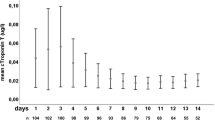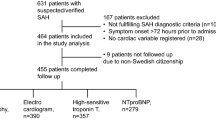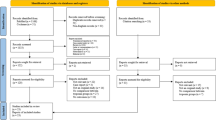Abstract
Background
Troponin and brain natriuretic peptide (BNP) levels are predictors of mortality following subarachnoid hemorrhage (SAH). Prior studies used strict cutoffs for BNP elevation; however, normal levels of BNP are increased in older persons and women. We explored the association of troponin elevation and BNP elevation adjusted for sex and age with 30-day mortality.
Methods
In this retrospective cohort study of patients with SAH, collected data included peak troponin T and BNP levels. Mortality data were obtained from inpatient mortality data and available records. Troponin T elevation was defined as more than 0.10 ng/mL; BNP elevation was defined as greater than the 95th percentile reference limit by age and sex for patients without cardiovascular disease. Associations of elevated troponin T and BNP were estimated from a log-binomial regression model reporting relative risks (RRs), 95 % CIs, and P values; missing data were imputed with the sample median or most frequent category.
Results
This study included 175 SAH patients. In single-variable analysis, peak troponin T level greater than 0.10 ng/mL was associated with increased risk in 30-day mortality (RR 4.38; 95 % CI 2.43–7.89; P < .001); there was no association with elevated peak BNP adjusted for age and sex (RR 1.13; 95 % CI 0.55–2.35; P = .74). There was no evidence suggesting that the combination of elevated peak BNP and elevated peak troponin increased the risk of 30-day mortality.
Conclusions
Elevated troponin was an independent predictor of 30-day mortality following SAH; however, when adjusted for age and sex, elevations in BNP did not have this association.
Similar content being viewed by others
Abbreviations
- BNP:
-
Brain natriuretic peptide
- GCS:
-
Glasgow Coma Scale
- RR:
-
Relative risk
- SAH:
-
Subarachnoid hemorrhage
- WFNS:
-
World Federation of Neurological Surgeons
References
Burch GE, Meyers R, Abildskov JA. A new electrocardiographic pattern observed in cerebrovascular accidents. Circulation. 1954;9(5):719–23.
Brouwers PJ, Wijdicks EF, Hasan D, Vermeulen M, Wever EF, Frericks H, et al. Serial electrocardiographic recording in aneurysmal subarachnoid hemorrhage. Stroke. 1989;20(9):1162–7.
Hunt D, McRae C, Zapf P. Electrocardiographic and serum enzyme change in subarachnoid hemorrhage. Am Heart J. 1969;77(4):479–88.
Sommargren CE, Zaroff JG, Banki N, Drew BJ. Electrocardiographic repolarization abnormalities in subarachnoid hemorrhage. J Electrocardiol. 2002;35(Suppl):257–62.
Andreoli A, di Pasquale G, Pinelli G, Grazi P, Tognetti F, Testa C. Subarachnoid hemorrhage: frequency and severity of cardiac arrhythmias: a survey of 70 cases studied in the acute phase. Stroke. 1987;18(3):558–64.
Sommargren CE. Electrocardiographic abnormalities in patients with subarachnoid hemorrhage. Am J Crit Care. 2002;11(1):48–56.
Banki NM, Kopelnik A, Dae MW, Miss J, Tung P, Lawton MT, et al. Acute neurocardiogenic injury after subarachnoid hemorrhage. Circulation. 2005;112(21):3314–9 Epub 2005 Nov 14.
Kopelnik A, Fisher L, Miss JC, Banki N, Tung P, Lawton MT, et al. Prevalence and implications of diastolic dysfunction after subarachnoid hemorrhage. Neurocrit Care. 2005;3(2):132–8.
Parekh N, Venkatesh B, Cross D, Leditschke A, Atherton J, Miles W, et al. Cardiac troponin I predicts myocardial dysfunction in aneurysmal subarachnoid hemorrhage. J Am Coll Cardiol. 2000;36(4):1328–35.
Pollick C, Cujec B, Parker S, Tator C. Left ventricular wall motion abnormalities in subarachnoid hemorrhage: an echocardiographic study. J Am Coll Cardiol. 1988;12(3):600–5.
Meaudre E, Jego C, Kenane N, Montcriol A, Boret H, Goutorbe P, et al. B-type natriuretic peptide release and left ventricular filling pressure assessed by echocardiographic study after subarachnoid hemorrhage: a prospective study in non-cardiac patients. Crit Care. 2009;13(3):R76 Epub 2009 May 20.
Hachinski VC, Smith KE, Silver MD, Gibson CJ, Ciriello J. Acute myocardial and plasma catecholamine changes in experimental stroke. Stroke. 1986;17(3):387–90.
Masuda T, Sato K, Yamamoto S, Matsuyama N, Shimohama T, Matsunaga A, et al. Sympathetic nervous activity and myocardial damage immediately after subarachnoid hemorrhage in a unique animal model. Stroke. 2002;33(6):1671–6.
Naredi S, Lambert G, Eden E, Zall S, Runnerstam M, Rydenhag B, et al. Increased sympathetic nervous activity in patients with nontraumatic subarachnoid hemorrhage. Stroke. 2000;31(4):901–6.
Sato K, Masuda T, Izumi T. Subarachnoid hemorrhage and myocardial damage clinical and experimental studies. Jpn Heart J. 1999;40(6):683–701.
Schuiling WJ, Dennesen PJ, Tans JT, Kingma LM, Algra A, Rinkel GJ. Troponin I in predicting cardiac or pulmonary complications and outcome in subarachnoid haemorrhage. J Neurol Neurosurg Psychiatry. 2005;76(11):1565–9.
Naidech AM, Kreiter KT, Janjua N, Ostapkovich ND, Parra A, Commichau C, et al. Cardiac troponin elevation, cardiovascular morbidity, and outcome after subarachnoid hemorrhage. Circulation. 2005;112(18):2851–6.
Tanabe M, Crago EA, Suffoletto MS, Hravnak M, Frangiskakis JM, Kassam AB, et al. Relation of elevation in cardiac troponin I to clinical severity, cardiac dysfunction, and pulmonary congestion in patients with subarachnoid hemorrhage. Am J Cardiol. 2008;102(11):1545–50 Epub 2008 Oct 1.
Tung P, Kopelnik A, Banki N, Ong K, Ko N, Lawton MT, et al. Predictors of neurocardiogenic injury after subarachnoid hemorrhage. Stroke. 2004;35(2):548–51 Epub 2004 Jan 22.
Ramappa P, Thatai D, Coplin W, Gellman S, Carhuapoma JR, Quah R, et al. Cardiac troponin-I: a predictor of prognosis in subarachnoid hemorrhage. Neurocrit Care. 2008;8(3):398–403.
Yarlagadda S, Rajendran P, Miss JC, Banki NM, Kopelnik A, Wu AH, et al. Cardiovascular predictors of in-patient mortality after subarachnoid hemorrhage. Neurocrit Care. 2006;5(2):102–7.
Sandhu R, Aronow WS, Rajdev A, Sukhija R, Amin H, D’aquila K, et al. Relation of cardiac troponin I levels with in-hospital mortality in patients with ischemic stroke, intracerebral hemorrhage, and subarachnoid hemorrhage. Am J Cardiol. 2008;102(5):632–4 Epub 2008 Jun 12.
Miketic JK, Hravnak M, Sereika SM, Crago EA. Elevated cardiac troponin I and functional recovery and disability in patients after aneurysmal subarachnoid hemorrhage. Am J Crit Care. 2010;19(6):522–8 Epub 2010 Jan 27.
Gupte M, John S, Prabhakaran S, Lee VH. Troponin elevation in subarachnoid hemorrhage does not impact in-hospital mortality. Neurocrit Care. 2013;18(3):368–73.
Redfield MM, Rodeheffer RJ, Jacobsen SJ, Mahoney DW, Bailey KR, Burnett JC Jr. Plasma brain natriuretic peptide concentration: impact of age and gender. J Am Coll Cardiol. 2002;40(5):976–82.
Garcia-Berrocoso T, Giralt D, Bustamante A, Etgen T, Jensen JK, Sharma JC, et al. B-type natriuretic peptides and mortality after stroke: a systematic review and meta-analysis. Neurology. 2013;81(23):1976–85 Epub 2013 Nov 1.
Krishnaswamy P, Lubien E, Clopton P, Koon J, Kazanegra R, Wanner E, et al. Utility of B-natriuretic peptide levels in identifying patients with left ventricular systolic or diastolic dysfunction. Am J Med. 2001;111(4):274–9.
Nakamura T, Okuchi K, Matsuyama T, Fukushima H, Seki T, Konobu T, et al. Clinical significance of elevated natriuretic peptide levels and cardiopulmonary parameters after subarachnoid hemorrhage. Neurol Med Chir (Tokyo). 2009;49(5):185–91.
McGirt MJ, Woodworth G, Thomas G, Miller N, Williams M, Rigamonti D. Cerebrospinal fluid shunt placement for pseudotumor cerebri-associated intractable headache: predictors of treatment response and an analysis of long-term outcomes. J Neurosurg. 2004;101(4):627–32.
Yancy CW, Jessup M, Bozkurt B, Butler J, Casey DE Jr, Drazner MH, American College of Cardiology Foundation/American Heart Association Task Force on Practice Guidelines, Writing Committee Members, et al. 2013 ACCF/AHA guideline for the management of heart failure: a report of the American College of Cardiology Foundation/American Heart Association Task Force on practice guidelines. Circulation. 2013;128(16):e240–327 Epub 2013 Jun 5.
Clavel MA, Malouf J, Michelena HI, Suri RM, Jaffe AS, Mahoney DW, et al. B-type natriuretic peptide clinical activation in aortic stenosis: impact on long-term survival. J Am Coll Cardiol. 2014;63(19):2016–25 Epub 2014 Mar 26.
Conflict of interest
The authors declare that they have no conflict of interest.
Author information
Authors and Affiliations
Corresponding author
Electronic supplementary material
Below is the link to the electronic supplementary material.
Rights and permissions
About this article
Cite this article
Duello, K.M., Nagel, J.P., Thomas, C.S. et al. Relationship of Troponin T and Age- and Sex-Adjusted BNP Elevation Following Subarachnoid Hemorrhage with 30-Day Mortality. Neurocrit Care 23, 59–65 (2015). https://doi.org/10.1007/s12028-014-0105-6
Published:
Issue Date:
DOI: https://doi.org/10.1007/s12028-014-0105-6




